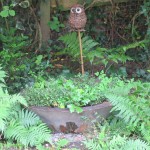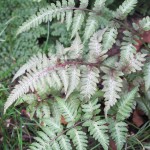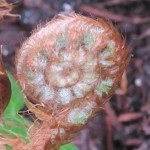

What to Grow on Dry, Shady, Chalky Soil.
My water garden was a large metal bowl on the patio, and in it grew a miniature water lily, golden grass and one or two other watery things. Then one winter it sprang a leak, and all I was left with was a mud filled bowl. Not that far away was a dull, dry patch, mostly earth and chalk lumps, where grass would hardly grow, overhung by shrubby things screening a fence. Suddenly it dawned. Of course, fernery.
 I placed the bowl in the middle of this patch, filled it with earth, and planted it with miniature harts tongue ferns from Hilliers. Around it I planted a tatting fern, and a hardy maidenhair fern from Fibrex plants, and added some ferns around the garden which seemed unremarkable though I always liked Polystichum because its hairiness gives it a soft ginger bloom, and in spring its fuzzy coils are lovely. Everything looked better partying together, including the usually dull Polypody. I planted some decent sized harts tongues, Adantium. I added Athyrium Lady in Red, a lady fern with
I placed the bowl in the middle of this patch, filled it with earth, and planted it with miniature harts tongue ferns from Hilliers. Around it I planted a tatting fern, and a hardy maidenhair fern from Fibrex plants, and added some ferns around the garden which seemed unremarkable though I always liked Polystichum because its hairiness gives it a soft ginger bloom, and in spring its fuzzy coils are lovely. Everything looked better partying together, including the usually dull Polypody. I planted some decent sized harts tongues, Adantium. I added Athyrium Lady in Red, a lady fern with  red stems, and the subtle Athyrium pictum – the Japanese painted fern, greyish and reddish, which had long been neglected in a pot near the back door.
red stems, and the subtle Athyrium pictum – the Japanese painted fern, greyish and reddish, which had long been neglected in a pot near the back door.
(Lady fern? It’s only a name, because of its daintiness, nothing to do with its reproductive habits. The male fern, Dryopteris, is usually bigger and coarser, and ditto, nothing to do with sex. Shield ferns and buckler ferns, they’re all male ferns, but when I turn the leaves over and examine the sori, the doughnut shaped spores which give the name, I find them impossible to tell apart.)
The dainty maidenhair never survived the winter, and the tatting fern, discovered as a sport of an ordinary lady fern in Ireland in Victorian times, reverted to being ordinary. The jolliest and utterly reliable fern is still the dear glistening harts tongue with its strap leaves glossy green above, striped with ginger spore cases underneath. It’s a native, and it really does like the chalk, dry or wet. You can buy all sorts of crimped and crested varieties, but I think plain is and best.
So there they are, backed by an owl made of rope. People are rude about collections, say that collections are boring, and just for obsessives. It’s not true. Because ferns are not stars competing for attention, they just are better appreciated in their own company. Here they can be compared and enjoyed for their own sake.
Then, there’s the beauty of their symmetry. A typical fern is like a series of self reflecting mirrors receding to infinity, as each frond bears further fronds, which bear more, smaller and smaller to vanishing point. I gasp when I think of their ancient origins – the fact they were growing aeons before conifers or flowers were around. And then, there’s their unfurling croziers in spring , nothing  else like them.
else like them.
I wondered about studding these ferns with hardy cyclamen, but no – the cyclamen would grab all the attention and the ferns would fade from sight. So just some large flints here and there. No gaudy flowers. Peaceful. Perfect in fact.
Copyright Sarah Coles 2018 Privacy Policy Website Design & Creation Forum Media and Design - Alresford